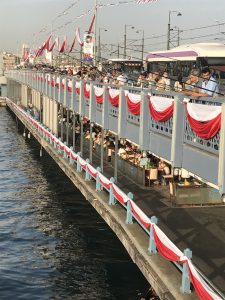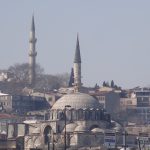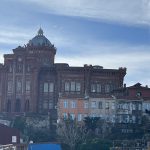It’s one of those great İstanbul landmarks that every visitor to the city sees without necessarily paying it the attention it deserves. The Galata Bridge provides the main crossing point between Old İstanbul and modern Beyoğlu just at the point where the Golden Horn meets and merges with the Bosphorus. It connects two busy and sometimes under-rated parts of the city – Eminönü to the south and Karaköy to the north – and these days you don’t even need to walk across since the tram transits the bridge at frequent intervals.
For most people Galata is that much-photographed bridge with masses of fishermen dangling their lines over the side at all times of day and night. For others it’s the bridge with all the fish restaurants running along its underside even if some will abhor the garish neon lighting used to advertise their wares. Visit any of the ones facing up the Golden Horn at sunset, however, and you’re in a for a treat.
On the Karaköy side of the bridge you’ll find the city’s colourful main fish market with, just behind it, a collection of much less garish and less touristy restaurants.
So famous is the Galata Bridge that an entire book has been written about it. Geert Mak’s The Bridge treats it as a metaphor for the larger city and contains interviews with many for whom it is a part of daily life. While it’s Edmondo de Amicis’ description of the colourful crowd passing over it that tends to get the most attention, it’s John Freely’s description in Stamboul Sketches (1974) in which he watches the “foul-tempered dwarf…Yaşar Kasım…waddling across the bridge to his hovel in the slums of Galata, his pelican perched on one leg on his shoulder” that most lingers in my mind.
Backstory
Until 1845 there was no permanent bridge across the Golden Horn despite the fact that designs for such a thing had been drawn up as early as the 16th century by Leonardo da Vinci and Michelangelo, amongst others. Today’s Galata Bridge, erected in 1994, is the fifth to stand on the site. The most famous, and the one most vividly described in his Constantinople by Edmondo de Amicis, was built in 1912.
Around the bridge
Before strolling across the bridge from the Eminönü side you might want to pause to inspect a couple of small and often overlooked monuments. The first is the Cafer Baba Kule (Tower), the sole tower to survive intact from the Sea Walls that used to protect the shores of the Golden Horn from marauders. Dating back to early Byzantine times, the tower came to serve as a prison, its most noteworthy inmate being the Cafer Baba after whom it was named. Cafer Baba had come to Constantinople in the late 8th century as an envoy from the Abbasid caliph but was thrown into jail here. After his death he was buried alongside the Ali Baba who had been his jailor and whom he had converted to Islam. It was apparently used as a debtors’ prison in late Ottoman towns.
The rectangular stone tower survived as an adjunct to the Zindan (Dungeon) Han, one of the early office blocks that evolved out of the medieval and Ottoman hans – it has been in business since at least 1890. For a while it was apparently used as a women’s prison. The Golden Horn views from the top floor are stunning. Just past it are the battered remains of what looks like a Byzantine gate, presumably leading to the waterfront. It was probably known as the Porta Caravion. In front of it was the Yemiş İskelesi where fruit and vegetables were brought to shore.
Just east of the Zindan Han is the small newly restored Ahi Çelebi Cami, built in 1523 but famous not so much for its so-so architecture but because the 17th-century Ottoman travel writer, Evliya Çelebi, said that it was after dreaming that he had fallen asleep here and been “advised” that he would do so that he want on to write his Seyahatname (Book of Travel).

Bridge that gave its name to a card game. As an old story has it, soldiers billeted in Galata during the Crimean War used to walk across the bridge to play cards in the Old City. Jokingly, they called the most popular game “bridge”, a name that is said to have stuck.
Eating
If you don’t want alcohol with your fish supper you can pick out your fish and then eat it right in the fish market.
Akın Balık The restaurants on the underside of the bridge may put on the biggest show but for the freshest fish in the prettiest setting you’re better off walking past the fish market in search of this small gem where a glass of wine is also readily available. Tel: 0212-244 9776
Transport info
There are handy tram stops on either side of the bridge at Eminönü and Karaköy.
Nearby areas



